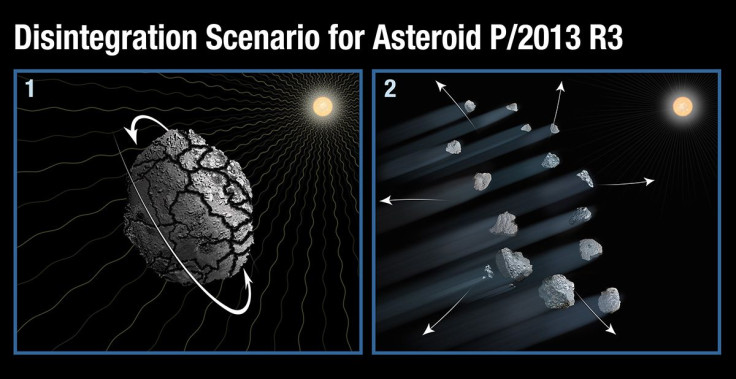NASA’s Hubble Snaps Rare Sight Of Asteroid Breaking Up Into Pieces [PHOTOS]

Breaking up of fragile comets -- space rocks that are made of ice and dust -- while approaching the sun is a common phenomenon, but the same activity had never been observed in the asteroid belt until NASA's Hubble Space Telescope snapped a never-before-seen disintegration of an asteroid into as many as 10 smaller pieces.
First noticed on Sept. 15, 2013, the crumbling asteroid, dubbed P/2013 R3, appeared as a fuzzy-looking object, while a subsequent observation from the W. M. Keck Observatory on the summit of Mauna Kea, an inactive volcano on Hawaii, revealed three bodies moving together in an envelope of dust of a size nearly the diameter of Earth.
“The Keck Observatory showed us this thing was worth looking at with Hubble,” David Jewitt of the University of California at Los Angeles said in a statement. “With its superior resolution, space telescope observations soon showed there were really 10 embedded objects, each with comet-like dust tails. The four largest rocky fragments are up to 400 yards in diameter, about four times the length of a football field.”
According to Hubble data, the asteroid began to break apart early last year, but its fragments are drifting away from each other very slowly at merely one mile per hour.
Astronomers said that factors, such as a collision with another asteroid, or the pressure of interior ices warming and vaporizing, are likely not the reason behind the mysterious disintegration of the asteroid.
The scientists believe there are possibilities that P/2013 R3 is disintegrating due to a subtle effect of sunlight that gradually increases the rotation rate of the asteroid, whose components gradually succumb to the central force and then pull apart.
“For this scenario to occur, P/2013 R3 must have a weak, fractured interior -- probably as the result of numerous non-destructive collisions with other asteroids,” NASA said, in the statement. “Most small asteroids are thought to have been severely damaged in this way. P/2013 R3 is likely the byproduct of just such a collision sometime in the last billion years.”
Astronomers said that the asteroid's remnants, weighing about 200,000 tons, could turn into meteoroids in the future, and a small fraction of the debris may blaze across the skies while others will eventually plunge into the sun.
© Copyright IBTimes 2024. All rights reserved.






















